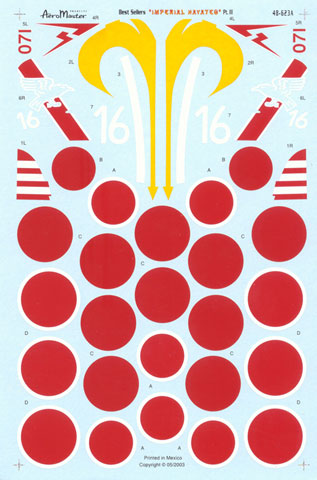S u m m a r y
|
| Catalogue
Number: |
AMD 48-623 Best Sellers -
Imperial Hayates Part III |
| Scale: |
1/48 |
| Contents and Media: |
Waterslide decals |
| Price: |
USD$9.00 MSRP from
Aeromaster's website |
| Review Type: |
FirstLook |
| Advantages: |
Good variety of markings;
crisply printed; perfect register; all markings supplied for all
aircraft |
| Disadvantages: |
|
| Recommendation: |
Recommended |
Reviewed
by Rodger Kelly

HyperScale is proudly supported by Squadron.com
AeroMaster Products sheet 48-623 is another in
their Best Sellers series. It provides markings for four Ki-84 Hayate
of the Imperial Japanese Army Air Force.
Ki-84 Ko of the1st Hiko-Sentai when it
was based in the Philippines in 1945. Finish is given as Nakajima
dark green over grey green with a red cowling ring, yellow ID wing
leading edges and a red and white striped rudder. The markings are
sparse but consist of:
·
 The
red and white striped rudder (a one-piece decal). The
red and white striped rudder (a one-piece decal).
·
National insignia (Hinomaru) in six places. The
fuselage and upper wing insignia have white borders whilst the ones on
the lower surfaces of the wings lack the border.
Ki-84 A of the 3rd Chutai, 1st
Fighter Regiment out of Taichun, Formosa in the summer of 1945. Finish
is Nakajima dark green over grey green with a yellow spinner, and
yellow ID wing leading edges. The aircraft bears the squadron’s
unique fin/rudder/fuselage marking, (in yellow denoting the 3rd
Chutai). Markings consist of:
·
National insignia as per the first aircraft.
·
The squadron insignia. This is supplied as a one-piece
decal so you will need patience and care when applying it or
alternatively, you could cut it into two pieces to make it more
manageable.
Ki-84 Ko of the 2nd Chutai 52nd
Hiko-Sentai, Shimodate airfield, Ibaraki Japan. Finish is Nakajima
dark green over grey green with a blue/black anti-glare and a red
spinner cap, and yellow ID wing leading edges. Markings consist of:
·
National insignia as per the first aircraft.
·
White ‘combat stripe’ around the rear fuselage.
·
Stylized squadron insignia for the fin and rudder in red
and white. Using a fair bit of imagination, the leading symbol looks
like a “V” or Roman numeral 5 and the second symbol an Arabic numeral
“2”.
·
Red 071 with white shadowing for the rudder.
Ki-84 A of the 502th Temporary
Interception Regiment based at Nakatsu airfield, Japan in 1945.
Finish is given as IJAAF dark green over light grey or natural metal
undersides with a red spinner, and yellow ID wing leading edges. As
this machine was employed on “Home Defence duties” it also bears the
white Home Defence Bands or “bandages”. The bandages are not supplied
so you will have to either paint them on or cut them from white decal
sheet. Markings consist of:
·
National insignia (Hinomaru) in six places.
·
Squadron insignia consisting of white-outline bird
(Eagle?) over a white bordered red band for the fin/rudder.
·
Numeral 16s in white for the cowling and the base of the
rudder.
·
White ‘combat stripe’ for the rear fuselage.
AeroMaster has been generous with this sheet in
that there are enough markings to produce each and every option
without having to find markings from other sheets. Also included are
eight yellow wing-walk warnings and black non-slips for the flaps.
The main decal sheet containing all of the markings have been printed
in Mexico whilst the smaller sheets containing the flap markings have
been printed in Italy.

The placement sheet is AeroMaster’s standard fare
of an A-4 sized sheet with colour drawings showing each aircraft in
profile as well as top views of the wings to show the flap data and
the Home Defence bands of the last option. As well as guidance on the
external camouflage finish the sheet also provides notes on painting
the propeller, anti-glare panel and the interior of the cockpit and
wheel wells. The decal sheets (three of them) and the placement guide
are packed in a clear plastic zip-loc bag.
The suggested kit is the superb Hasegawa one.
The placement sheet advises that the markings have been tailored for
this kit and not the ancient Tamiya or Otaki/Arii efforts.
The placement guide provides a comprehensive list
of references but one you might want to add to the list is J-Aircraft.Com.
http://www.j-aircraft.com/ to the list.
This is an excellent site that provides detailed information on
aircraft flown by the Japanese military during WWII.
A nice sheet from AeroMaster.
Recommended.
Thanks to AeroMaster
Products for the review sets
On-line sales are available from the
AeroMaster Products /
Eagle Strike Productions web site.
Review TextCopyright © 2003 by
Rodger Kelly
This Page Created on 28 August, 2003
Last updated
28 August, 2003
Back to
HyperScale Main Page |
Home | What's
New | Features
| Gallery |
Reviews | Reference
| Forum
| Search